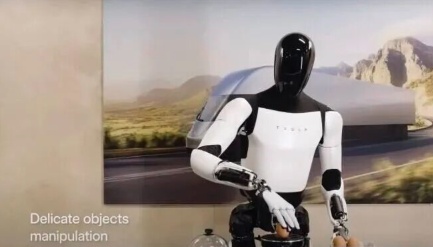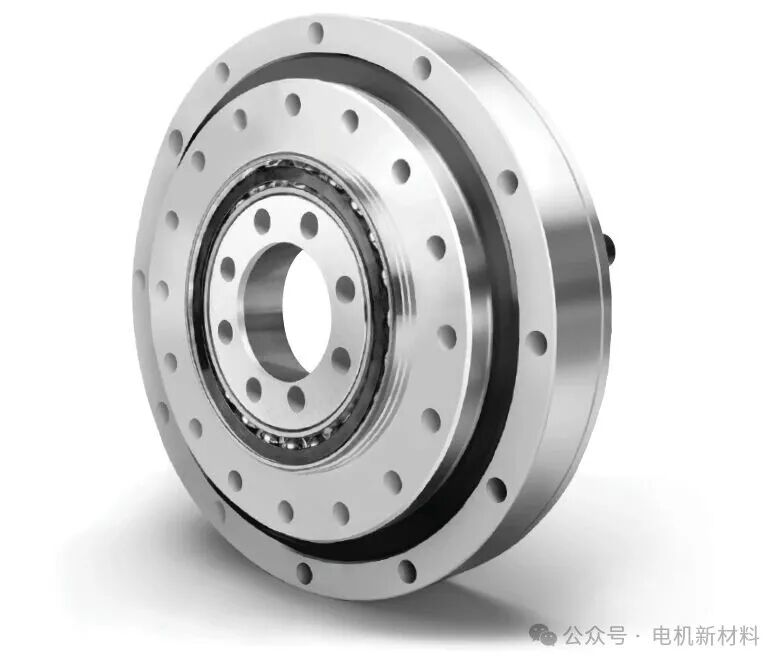The humanoid robots represented by Tesla's Optimus have attracted widespread attention. Behind the dazzling demonstrations, an urgent engineering challenge has gradually emerged—the heat dissipation problem of joint drive motors.
In April this year, during the half marathon for humanoid robots held in Beijing Yizhuang, multiple robots "overheated" and malfunctioned due to their joints overheating, forcing staff to run alongside them while spraying cooling agents.
When a high power density motor is integrated with a gearbox within a fist-sized space and operates continuously at high speed, heat accumulates rapidly, making the joint akin to a sealed pressure cooker, with temperatures rising up to 120°C. Overheating will lead to a decay in motor torque output, a reduction in positioning accuracy, and accelerated material aging, thereby shortening its lifespan.
To enable humanoid robots to truly achieve long-term autonomous operation, the heat dissipation issue of joint drives urgently requires a systematic solution from the engineering community.
Challenges of Joint Motor Cooling
The joint drive of humanoid robots has stringent performance requirements. It must be able to deliver high torque instantly while also enabling prolonged continuous motion, all within the constraints of lightweight and compact design. This is vastly different from traditional industrial robots, which often use external servo motors with extended linkages, having ample space to install fans or heat sinks. In contrast, humanoid robots are mostly designed with integrated joint modules—densely packing motors, reducers, sensors, and drivers within the joint itself. The confined and sealed space, combined with the dual heat sources from the motor and reducer, results in heat that cannot be dissipated in a timely manner.
The frictional heat generated by the reduction gears combines with the copper and iron losses in the motor windings, causing a rapid rise in joint temperature. This changes the viscosity of the lubricant and causes uneven thermal expansion of the components, further increasing friction and transmission errors, creating a vicious cycle.
The humanoid robot has a large number of joints distributed throughout its body. The Tesla Optimus has 28 degrees of freedom joints in total, and the cumulative effect of heat generation in each joint may endanger the stability of the entire machine.
To ensure safety, many prototypes currently operate only in short-term demonstrations or light-load scenarios. Once continuous high-load operation exceeds a certain period, it triggers overheating protection or necessitates performance reduction. As humanoid robots are applied in industrial and production settings in the future, the importance of thermal management will become increasingly prominent due to the significant increase in working hours and loads.
The thermal dissipation capability of joints will become one of the key bottlenecks for the reliability and durability of humanoid robots.
Mainstream Cooling Solutions in the Industry
The industry has explored various thermal management solutions for joint motors. Overall, these can be divided into two main approaches: enhancing heat conduction capability and active cooling for temperature reduction, often combined with motor process optimization to reduce heat generation.
-
High Thermal Conductivity Materials and Interface Optimization:
Improve the conduction path of internal heat flow in joints. Add high thermal conductivity fillers such as graphene and hexagonal boron nitride to the motor stator and coil varnish materials to create high thermal conductivity potting materials, enhancing the efficiency of heat transfer from the windings to the casing.
Thermal interface materials such as thermal grease and thermal pads are also used between internal power modules and mechanical components to fill tiny gaps and eliminate thermal bottlenecks. Some manufacturers use carbon fiber or copper alloy to make motor housings and frames to take advantage of their higher thermal conductivity to accelerate heat dissipation.
Mature technologies from consumer electronics, such as graphite sheets and vapor chambers, are also being introduced into joint modules. As ultra-thin thermal conduction components, they can rapidly transfer localized heat to a larger external surface area for dissipation.
This type of distributed passive cooling solution has a simple structure and high reliability, making it especially suitable for humanoid robot joints in confined spaces that aim to avoid additional energy consumption.
Active cooling inevitably becomes an option for high-power joints.
The industry currently has two main solutions: air cooling and liquid cooling.
In terms of air cooling, some companies have innovatively embedded mini fans into joint cavities. The patented design by Unitree Technology integrates a coaxial small fan directly blowing at the heat source within the joint connector, and features dual airflow channels and cooling fins. It is claimed that this can improve cooling efficiency by over 30% without adding external components.
1. Thigh rotation power unit; 2. Calf rotation power unit; 3. Thigh linkage; 4. Calf linkage; 5. First cooling fan; 6. Adapter; 7. Cooling air intake channel; 8. Cooling air exhaust channel.
In terms of liquid cooling, the heat capacity of liquids is much higher than that of air, which has a significant effect on continuously high heat flux density joints. Liquid cooling can be further divided into two types: circulating water cooling and immersion oil cooling.
The circulating water cooling system arranges micro cooling liquid channels within multiple joints, connecting them through hoses to the whole-body cooling circuit, which carries the heat to the cooling radiator on the back of the robot for dissipation.
Immersed oil cooling involves directly filling the joint cavity with insulating cooling oil, allowing the motor stator and windings to dissipate heat through immersion. If necessary, a small pump can be used to circulate the oil. The advantage of the oil-immersed method is its relatively simple structure and the lack of complex piping. A Japanese research team once applied a similar "motor sweat gland" design for the joints of humanoid robots, allowing moisture to seep out through a porous structure and evaporate, taking away heat.
Photo from University of Tokyo
The Kengoro robot's framework is made from aluminum powder laser sintering, and the robot can transport moisture from the internal porous layer to the porous layer near the surface of the framework, where it eventually evaporates.
In the new generation of products, Zhiyuan Robot's PowerFlow joint module integrates an integrated liquid cooling circuit, with a peak torque exceeding 350 N·m, while the joint weight is only 1.6 kg. Liquid cooling can efficiently dissipate the heat generated by the windings and magnets from the joint, but it also increases the system complexity and potential leakage risks.
Tesla and other companies face challenges when evaluating air cooling and liquid cooling. Air cooling requires an independent fan motor for each joint, while liquid cooling requires the arrangement of pipes and pumps throughout the entire body.
This has prompted the industry to actively seek compromise solutions, with phase change materials being considered for application. Phase change heat dissipation modules use materials such as paraffin to absorb peak heat from motors and release it during cooling, which is expected to stabilize temperature fluctuations. Currently, Broad-Ocean Motor is collaborating with Harbin Institute of Technology, Shanghai Jiao Tong University, and others to develop such joint phase change heat dissipation modules to address overheating issues.
Winding and structural process optimization.
Using flat wire windings instead of traditional round wire can improve the slot filling factor and heat dissipation contact area, resulting in lower copper losses and easier heat conduction. Companies like Dayang Electric have applied flat wire motor technology from electric vehicles to the joint drive of humanoid robots, and combined it with high heat-resistant insulation and advanced silicon steel materials, significantly reducing winding heating.
On the other hand, the joint structure tends toward heat source separation and shorter conduction paths. Taoshi Intelligence proposed a "separated" joint where the motor and the reducer are physically separated: the motor is placed in a larger space farther from the joint axis and is connected via a drive shaft, preventing the motor's heat from accumulating directly in the joint. This design also introduces an internal oil cooling cycle and a multi-tooth meshing low-friction reducer, significantly reducing the temperature rise of the joint.
Micro annular enveloping multi-tooth meshing reducer developed by Tao Shi Intelligent Technology.
Sumitomo Heavy Industries' Fine Cyclo® reducer is widely used in robotic joints due to its multi-tooth transmission and high efficiency characteristics, which help reduce transmission loss and heat generation.
Sumitomo Heavy Industries Precision Cycloidal Gear A Series FC Type
Supply chain technology reserve
The thermal management requirements of humanoid robots also profoundly impact the layout of the upstream and downstream industrial chains. Around the heat dissipation of joint motors, various core component suppliers and material manufacturers are actively developing corresponding technologies and accelerating the implementation of solutions through collaboration.
Power-driven enterprises:
Germany's ZF leverages its experience in the automotive transmission field to develop high torque density joint actuators and explores collaboration with leading domestic companies in the area of automated production line robotics.
Wolong Electric Drive recently launched an integrated joint power system for humanoid robots, focusing on enhancing heat dissipation and control performance. They have also become shareholders of the innovative robotics company Zhiyuan Robotics.
Daiyang Electric Motor announced that its third-generation humanoid robot dedicated motor is under development, emphasizing the transplant application of the 10,000-hour faultless automotive motor standard and servo motor temperature rise control technology, which can reduce the energy consumption of robot motors by 15%. At the same time, it has established a research and development center in collaboration with Tongji University and is jointly developing a phase change heat dissipation joint module with Harbin Institute of Technology, clearly targeting joint overheating as a key challenge.
Nidec is also targeting this market, not only by launching the high-precision FLEXWAVE® series reducers to provide zero backlash and low vibration transmission solutions for joints, but also by assisting Toyota in developing the T-HR3 humanoid robot servo joints through its subsidiaries Nidec COPAL and Tamagawa, integrating torque sensors to achieve safe force control.
Source of the image: Nidec
The involvement of these transmission and motor companies provides humanoid robots with high-performance, reliable joint actuators and lays the foundation for thermal management. Higher efficiency and better electromechanical integration mean less unnecessary heat loss and easier heat dissipation.
The contradiction between high power density, small size and lightweight, and long endurance makes heat dissipation an unavoidable challenge for humanoid robots.
Fortunately, various industries have demonstrated unprecedented innovative vitality.
A comprehensive multi-level solution combination is taking shape, from high thermal conductivity materials, embedded air cooling, liquid cooling circuits to phase change heat dissipation and new-type reducers. Leading companies in the fields of motors, electronics, and materials are entering the market one after another, accelerating the application of these new heat dissipation technologies to actual products through technological cooperation and supply chain integration.
It is foreseeable that in the coming years we will see a significant improvement in the joint heat dissipation capability of humanoid robots.
【Copyright and Disclaimer】The above information is collected and organized by PlastMatch. The copyright belongs to the original author. This article is reprinted for the purpose of providing more information, and it does not imply that PlastMatch endorses the views expressed in the article or guarantees its accuracy. If there are any errors in the source attribution or if your legitimate rights have been infringed, please contact us, and we will promptly correct or remove the content. If other media, websites, or individuals use the aforementioned content, they must clearly indicate the original source and origin of the work and assume legal responsibility on their own.

















